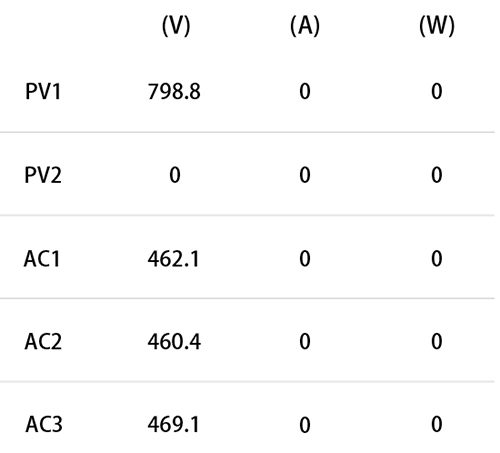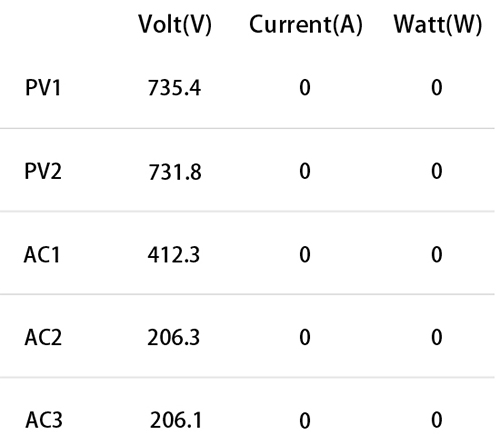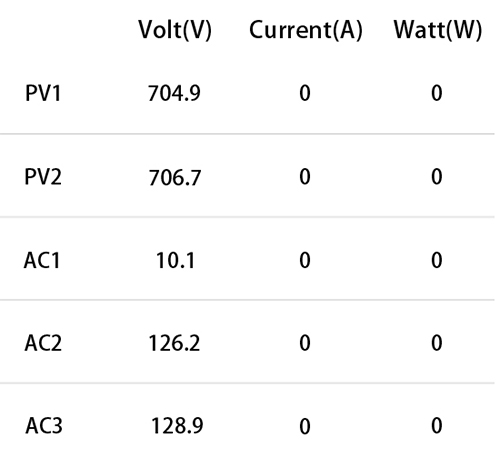The AC voltage overrange is the most common failure of the solar inverter connected with the PV grid system. This is because the grid voltage is not constant and it will change with the changing of the load and current. At the same time, the output voltage of the inverter will be affected by the grid voltage. When the grid encounters abnormal situation, the inverter power supply shall be stopped to avoid more serious damage on the grid.
Based on the national standard, the protection range of the under-voltage and over-voltage at the AC output side is the 85%-110% of the rated voltage. The solar inverter operation shall be stopped when it exceeds this range. The rated voltage of the single-phase grid is 230V. when the grid voltage is lower than 195.5V or is higher than 253V, principally the inverter shall be stopped. The rated voltage of the three-phase grid is 400V. When the grid voltage is lower than 340V or is higher than 440V, principally, the inverter shall be stopped.
1. Overvoltage caused by rising of power grid voltage
The grid voltage will be relatively high at two places. The first one is the place close to the step-down transformer. To ensure the normal voltage of the place close to the transformer and considering the voltage loss of the wire, normally the transformer output voltage will be increased. The second factor is that as the PV power generation terminal user can not accept it, it is necessary to improve the voltage when power is delivered to remote place. Thus, the output voltage of the solar inverter will be high, which will trigger the inverter protection function and the inverter working will be stopped.

Under this situation, there are three methods to keep the solar inverter working continuously.
- The first method is to increase the output cable diameter. This is because when the cable is thick, the resistance can be decreased.
- The second method is to move the inverter to a place close to the grid connection point because the short cable distance can help reduce the resistance.
- The third method is to adjust the inverter voltage range manually. But the voltage can not be adjusted to a very high level. If the voltage exceeds 270V, other electrical appliances may be damaged.
2. Overvoltage caused by wrong connection of AC wire
If the AC wire of the solar inverter is connected in a wrong way, the AC voltage overrange failure may be caused. If the phase wire and zero wire are connected wrongly, then the inverter A phase will show that the line voltage is 380V and the B, C will show that the phase voltage is 220V. Then the inverter can not be started because the system judges that the voltage is too low. This situation usually appears during the solar inverter installation stage.

As shown in the above photo, the system reminds that the AC voltage exceeds the required range. It can be seen from the monitor APP that the phase voltage of AC1 is normal but AC2 and AC3 are relatively low. After the site inspection, it is found that this is because the phase line L1 and the zero line N are connected in an opposite way. When they are exchanged back, the solar inverter works normally.
3. Overvoltage caused by poor contact or damage of AC switch
The poor contact or the damage of the AC switch will also lead to the AC voltage overrange failure of the solar inverter. The AC switch behind the inverter will work for long time. If the cable end is not well pressed and connected or if the switch quality is not good, high resistance will be caused in the connection place and then the voltage will be decreased.

As shown in the above photo, the AC voltage overrange alarm is generated by the power station. It can be found from the monitor APP that the phase voltage of AC1 is 10.1V, of AC 2 and AC3 is separately 126.2V and 128.9V. However, based on the site measurement, the grid voltage is normal and the switch is not turned off. But the switch temperature is relatively high. When opening the cable connection terminals, it is found that the connection point is blackened. The voltage becomes normal after changing new cable connection point and switch. Then, the solar inverter is back to normal operation.
How to inspect the AC voltage failures?
- Firstly, the multimeter can be used to detect the grid voltage. If the voltage is abnormal, it means the problem is caused by the grid.
- Secondly, the AC switch can be tested. Normally, when the switch is turned on, the switch conducting the current from upward to downward direction normally and there is no voltage between the input wire and the output wire. However, if it is found that the voltage is over 5V, it means the switch has problem.
- Thirdly, if it is confirmed that the problem is not caused by the AC switch. The AC wire output terminal of the solar inverter shall be inspected. The multimeter can be used to detect the voltage among the phases of the wire terminal and the detected voltage shall be consistent with the grid voltage. If it is not consistent, the problem may be caused by the cable between the switch and the inverter or may be caused by the inverter output terminal. Finally, if it is confirmed that the AC wire output terminal voltage is normal but the inverter AC voltage failure alarm still exists, the alarm may be caused by the internal sampling system of the solar inverter and users shall contact the inverter manufacturer to solve the problem.
